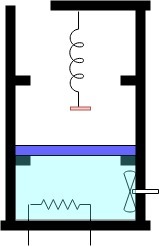Upgrading thermodynamics!

A piston-cylinder device that has stops and a linear spring ( ) as shown in the diagram above, contains of water initially at . Water is stirred by a paddle wheel while a current of at flows for an hour through a resistor placed in the water. Cross section of piston is , and the thickness of piston, the stops and the spring-pad are negligible. The lower stops, spring-pad and upper stops are at a height of , and respectively from the base of piston-cylinder arrangement. The piston requires a minimum pressure of to float.
The entire arrangement is adiabatic and the process is assumed to be quasi-equilibrium. In the final state, the pressure is . Find the paddle work with appropriate sign convention (in ) in this process.
Note: The problem solver is meant to only use the data from steam tables for noting various thermodynamic properties wherever necessary.
The answer is -815.483.
This section requires Javascript.
You are seeing this because something didn't load right. We suggest you, (a) try
refreshing the page, (b) enabling javascript if it is disabled on your browser and,
finally, (c)
loading the
non-javascript version of this page
. We're sorry about the hassle.
0 solutions
No explanations have been posted yet. Check back later!